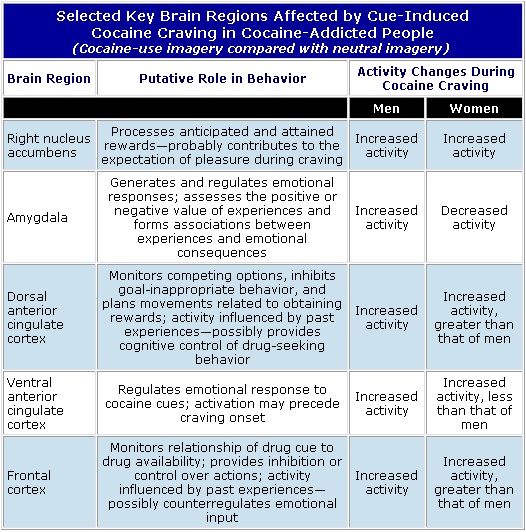Men and Women May Process Cocaine Cues Differently
Download PDF Version What is PDF?
Lori Whitten
Lori Whitten is a Staff Writer for NIDA NOTES.
Source: NIDA NOTES, Vol. 19, No. 4, December, 2004
Public Domain
Table of Contents (TOC)
Article: Men and Women May Process Cocaine Cues DifferentlyReferences
Some aspects of cocaine addiction and recovery are different for men and women—including the reasons for seeking drug rehabilitation, response to treatment, and vulnerability to relapse. Women are more likely to seek cocaine abuse treatment in response to co-occurring depression, remain abstinent after treatment, and relapse in response to interpersonal problems and negative feelings. Cocaine-addicted women also demonstrate greater craving than men in response to drug cues. In the first brain imaging study of cocaine craving by cocaine-addicted women, NIDA-funded researchers have made observations that, if borne out in larger studies, may point to neurological sources of these differences.
Dr. Clinton Kilts and colleagues at the Emory School of Medicine in Atlanta used positron emission tomography (PET) to measure drug-craving-related changes in regional cerebral blood flow—a correlate of neural activity—in eight cocaine-addicted African-American women aged 35 to 46. The women had abstained from cocaine use for 1 to 14 days and reported frequent periods of cocaine craving in the 30 days preceding the study. While lying in the PET scanner, each woman listened to a 1-minute recording of a script describing her personal experiences of acquiring the drug and anticipating sensations associated with taking cocaine. Each patient’s script was derived from her own answers to an autobiographical questionnaire and narrated in the first person:
 "...I start thinking about how good it’s going to feel to take that
first hit...with my eyes wide open I take my lighter out of my pocket,
put it to the stem, and get ready to take that first, good blast...."
"...I start thinking about how good it’s going to feel to take that
first hit...with my eyes wide open I take my lighter out of my pocket,
put it to the stem, and get ready to take that first, good blast...."
The researchers injected each woman with a radiotracer and took pictures of the blood flow in her brain as she listened to the script and relived the scene in her mind. After each brain scan, the women rated the urge to use cocaine, vividness of the mental image, and their emotions. They repeated this process twice.
The women also underwent imaging in three control situations: resting, listening to a script of a personal experience in nature, and listening to a script designed to provoke anger. The researchers verified that the mental imagery of the cocaine-related script induced a greater urge to use cocaine than the nature or anger script. By comparing the brain scans produced in response to the different scripts, the researchers were able to evaluate cerebral blood flow while the women were craving cocaine versus when they were relaxed and not thinking of the drug. The procedure also distinguished changes related to craving from those that might simply reflect strong general emotional reactions (as in the anger-inducing script). To examine possible sex differences in the neural representation of cocaine craving, the investigators compared the findings in women with results from eight cocaine-addicted men of similar ages and backgrounds who experienced the same process.
Brain Response Differs in Men and Women During Cue-Induced Craving
 These PET scans show differences in blood flow between a neutral state and a cocaine-craving state. White areas indicate an increase in blood flow. Most notable is the decrease in blood flow in the women’s amygdala (top right panel) during craving; men show an increase in blood flow during craving (bottom right panel).
These PET scans show differences in blood flow between a neutral state and a cocaine-craving state. White areas indicate an increase in blood flow. Most notable is the decrease in blood flow in the women’s amygdala (top right panel) during craving; men show an increase in blood flow during craving (bottom right panel). In both men and women, cue-induced cocaine craving activated several brain areas involved in determining a cue’s reward value and controlling reward-related behaviors, including the right nucleus accumbens—a structure that seems to produce the expectation of pleasure during drug craving (see table, "Selected Key Brain Regions Affected by Cue-Induced Cocaine Craving in Cocaine-Addicted People"). "These common activations suggest that both sexes may process cocaine-use memories—mental images that are associated with strong emotions—as cues that guide reward-based decision making," says Dr. Kilts. However, men and women also showed some dissimilar neural responses to cocaine cues. Most notably, activity of the amygdala—a structure that assesses whether an experience is pleasurable or aversive and connects the experience with its consequences—fell in women during cocaine craving. "This finding is notable because our study and others have shown cue-induced amygdala activation in men," says Dr. Kilts. "Reduced neural responses in the amygdala may result from greater activation of the frontal cortex in women. The frontal cortex inhibits the activity of structures involved in emotional responding to drug cues, and our observations were consistent with previously reported sex differences in frontal cortical areas."

"As a field, we need more and better controlled studies of sex differences in factors that cause relapse," says Dr. Kilts. Combining imaging technologies in the same study—for example, PET with magnetoencephalography— would improve the localization of neural activity. "We could better define the neural responses that occur before, during, and after drug cues—illuminating the temporal sequence of the craving experience in men and women," he says.
"This research reveals that men and women differ in a critical brain area in their responses to cocaine craving," says Dr. Steven Grant of NIDA’s Division of Clinical Neuroscience, Development, and Behavioral Treatments. "Differences in the amygdala may indicate that male and female abusers crave the drug for different reasons or hope to achieve different results from taking the drug. Imaging studies that examine gender differences in specific behavioral aspects of drug craving will provide insight on how to tailor treatment programs to meet the needs of men and women."
Kilts, C.D.; Gross, R.E.; Ely, T.D.; and Drexler, K.P.G. The neural correlates of cue-induced craving in cocaine-dependent women. American Journal of Psychiatry 161(2):223-241, 2004.


